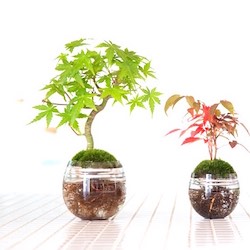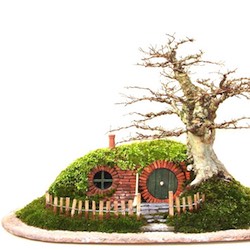One of the most widely debated subjects for most Bonsai enthusiasts is soil composition. Good Bonsai is not merely on the design, but a good Bonsai should portray a healthy tree that grows in a small container and this strongly depends on the soil used.
It is the fact that still many people have misperception that Bonsai is being tortured to be small, and this is absolutely wrong. Bonsai need extra loving cares and suppose to be healthier than a tree living in the nature due to the limited space it grows. Either the misperception or the unavailability of good quality soil, there are still many Bonsai are planted with poor quality soil which consequently affect the slow growing, unhealthy foliage or even sudden death of the tree.
Because Bonsai is planted in a relatively small quantity of soil throughout the year on which its existence depends. Through the soil in the pot, the tree must be able to obtain water, nutrients and air in order to grow for very long time. For this reason, a Bonsai must be planted in a good quality Bonsai soil.
The quality of the soil that is used, directly affects the health and vigor of the tree. It is my experience that unhealthy trees that lack vigor are very often planted in a poor (often organic) Bonsai substrate; or the worst some are planted in normal ground soil. Such soil easily harden when get dried which give no advantage to the growth of Bonsai. contrary it is very harmful to the tree.
There are a number of qualities that are required in a good soil mix
- Good water-retention. The soil needs to be able to hold and retain sufficient quantities of water to supply moisture to the Bonsai between each watering.
- Good drainage. Excess water must be able to drain immediately from the pot. Soils lacking good drainage are too water retentive, lack aeration and are liable to a build up of salts. Too much water-retention will also cause the root rot and kill the tree.
- Good aeration. The particles used in a Bonsai mix should be of sufficient size to allow tiny gaps or air pockets between each particle. Beside the need of oxygen for the roots, it is also important to let the good bacteria, mycorrhizae to live so the processing of food will take place before being absorbed by the root-hairs and send to the leaves for photosynthesis.
- A particle-based, well-structured inorganic soil allows fast drainage of water and allows fresh air to continually enter the soil. A compacted organic soil that lacks any structure also lacks aeration and drainage and this can lead to ill health in the roots and tree and root rot.
Organic or Inorganic Soils
Soil mixes are described as being either organic or inorganic. Dead plant matters such as peat or leaf-litter or bark are described as being organic soil components. Inorganic soil mixes contain little to no organic matter such as volcanic lava, calcite (baked) or fired clays.
Organic Soil
In past decades, Bonsai enthusiasts tended to use organic soil mixes, using a large proportion of peat, bark and leaf-litter mixed with grit to aid with drainage. As time passed, the knowledge and understanding of Bonsai increased, it is now acknowledged by most enthusiasts that organic soil components such as peat are not conducive to the good health and vigor of a tree.
Peat and other organic soil components have many disadvantages; they can be too water retentive, leading to the soil being continually sodden, particularly during periods of rain in Autumn, Winter and Spring. Conversely, during periods of high temperatures, dry peat can be difficult to thoroughly water, leaving dry spots inside the root ball of the bonsai; and this will be harmful for the growth of root-hairs. Tree without healthy root-hairs will never have healthy foliation; and tree without healthy foliation will grow very slow and easily die.
Possibly the most serious problem with organic soils is that though they may consist of appropriate sized particles when the Bonsai is first planted, they continue to break down in a Bonsai pot and become compacted. As the soil compacts it becomes airless and drains poorly. Such waterlogged and airless soils soon suffocate the roots and can lead to rotting roots and ill health in a Bonsai. Furthermore, the compacted soil will cause problem when repotting because it is difficult to wash out the old soil or will damage the root-hairs which may lead to the death of the bonsai.
Inorganic Soil
The advantage of inorganic materials is that they hold their open structure for a long time without breaking down into mush. Inorganic materials retain a certain quantity of water and any excess is immediately flushed through the bottom of the pot; Akadama is Japanese baked clay, Akadama is the soil of choice for many Japanese Bonsai Masters and enthusiasts. This is partially due to its relatively low price in Japan where it is also easily obtainable, but very expensive outside Japan. However, while Akadama might be considered a good quality soil, but in fact no better than the cheaper and more easily obtainable fired-clay soils that are available in some countries. Furthermore, Akadama can break down into a solid mush within 1 or 2 years. This old soil must therefore be washed out of the roots every one to two years. For this reason it is not recommended for species that will not tolerate regular bare-rooting (Pines for instance).
Advantage of volcanic lava soil
- Another inorganic soil considered as the best for Bonsai is volcanic lava, but not easily obtained in some countries where no volcanoes found.
- Originally natural. From volcano containing natural nutrients which benefit to trees.
- Porous. The porosity is beneficial to the growth of root-hairs. Healthy root-hairs will give healthy foliation that lead to healthy tree.
- Good water-retention. Water-retention is important to maintain the sufficient quantity of water in the soil to keep the moisture.
- Good drainage. Good drainage will maintain the quality of the soil, avoiding too much water that may cause the root rot and kill the tree.
- Good aeration. Good oxygen flow in soil is important for the living of good bacteria, mycorrhizae to live which is needed to process the food in the soil.
- Not easily break down. Break down will form the soil to solid mush and disturb the drainage and aeration. The compacted soil will also disturb the growth of root-hairs and damage the root system during repotting.
- Neutral in ph. The neutral ph around….is suitable for all kind of bonsai.
- Inexpensive. Volcano lava is much cheaper compare to other inorganic soils and costless in comparison to the benefit.




The root system is perfectly maintained with the root-hairs undisturbed. This is the condition expected by Bonsai enthusiasts when doing the repotting to make sure the Bonsai will be healthily survive after repotting.
Root System Condition Of Using Different Soils


This Bonsai has been growing in the pot for more than 3 years. When taken out from the pot, the root ball shows a very compacted soil condition without root-hairs. This is the result of poor quality soil where the root system can not grow healthily.

Simply by soaking in the water, all the soils are loosening off without damaging the root system and the root-hairs are well remained. This is the result of good drainage and no break down of lava soils. This condition ensures the Bonsai will continue to grow faster and healthily survive after repotting.

The sticky soil can only be washed out by high-pressure water spray; but this will damage the root-hairs. This is the result of poor drainage, poor aeration and the easy break down of the soils. Bonsai will never grow well in such soil condition. Although this Bonsai has been growing for more than 3 years, but the root system does not grow well with very few root-hairs; and the worst is that all the root-hairs will be destroyed and washed out with the sticky soils during the cleaning. This can easily kill the trees if this happens to conifers (pines and junipers). By changing to use volcanic lava soils, will make this Bonsai grow much faster and healthier.
Tips For Bonsai Potting & Repotting
The best season for Bonsai potting or repotting is early spring or early autumn and NEVER in winter. The reason that most of trees are giving new shoots starting spring and autumn. The best time to repotting Bonsai is when the Bonsai is still in healthy condition and do not wait until the Bonsai starting getting weak. The reason is when we do repotting, the tree will get disturbed and a weak Bonsai may not be able to challenge the stress and can get worse.
The repotting interval depends on the tree species; some trees (broad leaf / deciduous trees) need more frequent repotting than conifers (pine and junipers). For conifers, do not repotting right after severe styling process or right after the carving of jin-shari. It is better to wait for one year. When repotting conifers, try not to disturb the root system especially the root-hairs; but on some deciduous trees, root pruning can be done. Any root pruning during the repotting is better followed by some pruning on the foliage, especially on deciduous trees.
Written by: Robert Steven, Indonesia - "Bonsai artist, collector and teacher who is traveling intensively around the world giving lectures, demos, workshops and judging. Own his permanent Bonsai display center in Jakarta, Indonesia with over 500 Bonsai collection and has won more than 200 awards in national and international contests. Well-known with his aesthetic and artistic approach in Bonsai art. His books “Vision of My Soul” and “Mission of Transformation” have become best-sellers Bonsai books. More information on his profile and Bonsai creations can be viewed at his Facebook account or here in his Bonsai artist profile; Robert Steven."




